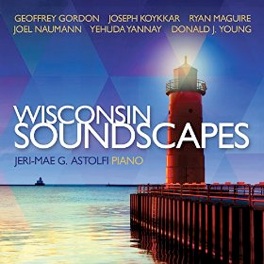
Wisconsin Soundscapes
Jeri-Mae G. Astolfi
2015 / Ravello Records
75 minutes
Review by Kathy Parsons
Wisconsin Soundscapes is a fascinating new project that features the compositions of six Wisconsin composers who were commissioned to create solo piano works inspired by Wisconsin themes of their own choosing. The music was recorded and performed by Jeri-Mae G. Astolfi, a leading proponent of new music that is far more avant-garde than new age or jazz. I am constantly amazed and impressed with Astolfi’s versatility as a pianist as well as her superb technique and total engagement with the music she performs. Most of this music is very edgy and esoteric, so if you are looking for spa music or music to lull you to sleep, this album probably will not work for you.
The project began in 2011 when the Wisconsin Alliance for Composers, Inc. was awarded a grant from the Wisconsin Arts Board. The commissioned composers - Geoffrey Gordon, Joseph Koykkar, Ryan Maguire, Joel Naumann, Yehuda Yannay, and Donald J. Young - were chosen through a double-blind selection process. Their pieces are based on various self-selected Wisconsin themes that include geographic locations, people, and scenes/events that include a herd of cows in a thunderstorm and the political turmoil leading up to the June 2012 gubernatorial recall election. A second Wisconsin Arts Board grant, awarded in 2012, supported subsequent presentations at community venues throughout the state, the underlying mission of the Wisconsin Soundscapes project.
The first three tracks are excerpted from Yehuda Yannay’s Midwestern Mythologist, a theatrical work composed as a tribute to his friend, Steve Nelson-Raney, a pianist, saxophone player, jazz musician, composer, poet, and visual artist who has lived and created in Wisconsin for many years. The three movements are “Three Little Satiesque Variations,” “Lines and Microlines,” and “Two Voice Bodies - Polar Twins.”
The next three pieces, “Three Root River Scenes,” were composed by Donald J. Young. “Good Times At River Bend” is one of the more melodic pieces on the album and reflects on times spent with his daughter exploring a nature center with her kindergarten class. “Cloudy Day, River Rising” foreshadows the coming storm and subsequent flood of 2008 - dark and ominous. “Pounding Rain, Raging River” depicts the storm and the frantic activity and heroic efforts that ensued to rescue and try to save as much as possible. This is a very dramatic and powerful work and Young’s trilogy is my favorite segment of the album.
Geoffrey Gordon contributed “Three Summer Sketches for Solo Piano,” which are sonic impressions of three Wisconsin towns: “Black Earth,” “Mineral Point,” and “Spring Green.” The last of the three pieces was inspired by the American Players Theater and Shakespeare’s plays performed under the stars. This piece is especially interesting in that it intertwines fragments of the music by Shakespeare’s contemporary, John Bull, with Gordon’s own musical language - the juxtaposition can be startling!
Joel Naumann’s “Wisconsin 2011-2012: The Political Whirlwind” is a set of seven variations with a duration of a little more than fourteen minutes. Each of the variations contains five subsections and the material used in each of the subsections remains constant throughout the seven variations. Often turbulent and discordant, the piece reflects on the protests and recall elections in Wisconsin during that period of time.
“Heard, for solo piano” by Ryan Maguire is about the discrepancies between how people perceive sound and how computers hear via machine listening techniques. All of the musical material is derived from a field recording of a herd of cows (and their cowbells) during a summer thunderstorm. An eighteen minute performance, quite a few passages are played with the fingers placed directly on the strings of the piano, creating interesting and sometimes eerie effects. Very slow and spatial, it’s a fascinating piece!
Joseph Koykkar’s “Streets and Bridges” is a three-movement work that reflects on places that were prominent in the composer’s younger years. “Downer Avenue” is bright and vibrant while “Lafayette Place” incorporates a variety of musical styles that reflect on Kokkar’s musical roots (my favorite of the three), and “Brady Street” expresses the vitality and energy of the neighborhood that became a center for the counterculture by the late 1960’s.
Wisconsin Soundscapes is not for all listeners or even all classical piano lovers, but if you are up to the challenge, this is a masterful collection. It is available for download from Amazon, iTunes, and Ravello Records.
May 24, 2015

